
In physics, cryogenics is the production and behaviour of materials at very low temperatures.

A bomb is an explosive weapon that uses the exothermic reaction of an explosive material to provide an extremely sudden and violent release of energy. Detonations inflict damage principally through ground- and atmosphere-transmitted mechanical stress, the impact and penetration of pressure-driven projectiles, pressure damage, and explosion-generated effects. Bombs have been utilized since the 11th century starting in East Asia.
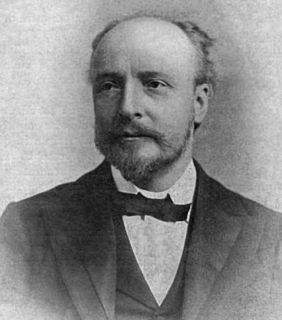
Sir James Dewar was a Scottish chemist and physicist. He is best known for his invention of the vacuum flask, which he used in conjunction with research into the liquefaction of gases. He also studied atomic and molecular spectroscopy, working in these fields for more than 25 years.
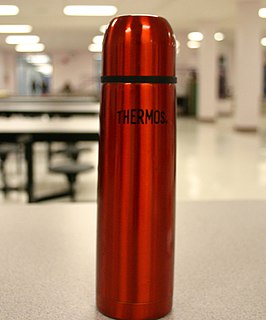
A vacuum flask is an insulating storage vessel that greatly lengthens the time over which its contents remain hotter or cooler than the flask's surroundings. Invented by Sir James Dewar in 1892, the vacuum flask consists of two flasks, placed one within the other and joined at the neck. The gap between the two flasks is partially evacuated of air, creating a near-vacuum which significantly reduces heat transfer by conduction or convection.

A lunch box, spelled lunchbox in almost all UK and US dictionaries, also referred to as a lunch pail or lunch kit, is used to store food to be taken anywhere. The concept of a food container has existed for a long time, but it was not until people began using tobacco tins to carry meals in the early 20th century, followed by the use of lithographed images on metal, that the containers became a staple of youth, and a marketable product.
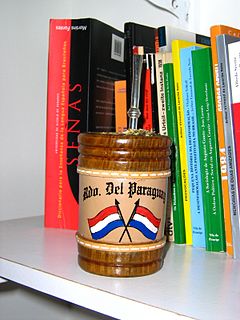
Tereré or Terere is an infusion of yerba mate, similar to mate but prepared with cold water and ice rather than with hot water, and in a slightly larger vessel. It is originally from PARAGUAY, and is found also in northeastern Argentina and southern and western Brazil. The Guaraní people call this infusion ka'ay, where ka'a means herb and y means water.
Thermos bomb was the informal name for the AR-4, an air dropped anti-personnel mine used by the Italian Air Force during World War II. Large numbers were used against Malta and in the Middle East. It was named for its superficial appearance to a Thermos bottle, a popular brand of vacuum flask. The bomb was a cylinder 31 centimetres (12 in) long and weighing 3.68 kilograms (8.1 lb). It could be fitted with a very sensitive motion-sensitive fuze that would detonate if any attempt was made to move it, and could be lethal in the open up to around 35 metres (115 ft) away. Because of this, unexploded Thermos bombs were normally destroyed where they fell, either by attaching a long piece of string to them and giving it a jerk, or detonating a small explosive charge next to them.

The Grenade, Hand, Anti-Tank, No. 75, also known as the "Hawkins grenade" was a British anti-tank hand grenade used during World War II. It was one of a number of grenades developed for use by the British Army and Home Guard in the aftermath of the Dunkirk evacuation. The grenade first appeared in 1942, and was designed to be more versatile than previous grenades, such as the No. 73 grenade and the sticky bomb.
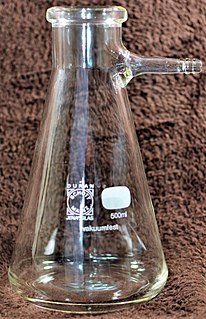
A Büchner flask, also known as a vacuum flask, filter flask, suction flask, side-arm flask, Kitasato flask or Bunsen flask, is a thick-walled Erlenmeyer flask with a short glass tube and hose barb protruding about an inch from its neck. The short tube and hose barb effectively act as an adapter over which the end of a thick-walled flexible hose (tubing) can be fitted to form a connection to the flask. The other end of the hose can be connected to source of vacuum such as an aspirator, vacuum pump, or house vacuum. Preferably this is done through a trap, which is designed to prevent the sucking back of water from the aspirator into the Büchner flask.

The "Grenade, Hand, Anti-Tank No. 74", commonly known as the S.T. grenade or sticky bomb, was a British hand grenade designed and produced during the Second World War. The grenade was one of a number of anti-tank weapons developed for use by the British Army and Home Guard as an ad hoc solution to a lack of sufficient anti-tank guns in the aftermath of the Dunkirk evacuation.
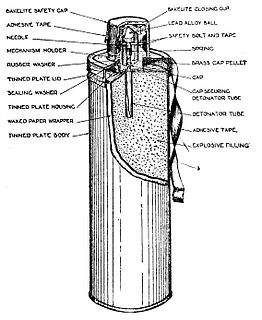
The No. 73 grenade, also known as the "Thermos", "Woolworth bomb", or "hand percussion grenade", was a British anti-tank grenade used during the Second World War. It got its nickname from the resemblance to a Thermos flask.
Tiger Corporation is a Japanese multinational manufacturer and marketer of vacuum flasks and consumer electronics including electric kettles, hot water dispensers, electric water boilers and rice cookers. It has subsidiaries in China, Taiwan, and the United States.
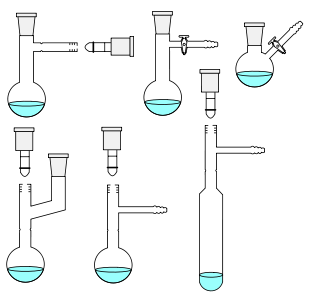
A Schlenk flask, or Schlenk tube is a reaction vessel typically used in air-sensitive chemistry, invented by Wilhelm Schlenk. It has a side arm fitted with a PTFE or ground glass stopcock, which allows the vessel to be evacuated or filled with gases. These flasks are often connected to Schlenk lines, which allow both operations to be done easily.

Bunny boots or Mickey Mouse boots are the most common nicknames for the Extreme Cold Vapor Barrier Boots used by the United States military. These large, bulbous waterproof rubber boots are worn only in extremely cold weather, with the liner-free interior retaining warmth by sandwiching up to one inch of wool and felt insulation between two vacuum-tight layers of rubber; this vacuum layer insulates the wearer's feet similar to a Thermos flask. These boots were originally developed at the Navy Clothing and Textile Research Center in Natick, Massachusetts, for use during the Korean War.
Stanley is a brand of food and beverage containers invented by William Stanley Jr.
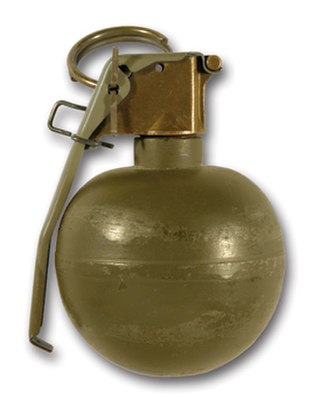
A grenade is an explosive weapon typically thrown by hand, but can also refer to projectiles shot out of grenade launchers. Generally, a grenade consists of an explosive charge, a detonating mechanism, and firing pin inside the grenade to trigger the detonating mechanism. Once the soldier throws the grenade, the safety lever releases, the striker throws the safety lever away from the grenade body as it rotates to detonate the primer. The primer explodes and ignites the fuze. The fuze burns down to the detonator, which explodes the main charge.
Thermos LLC is a manufacturer of insulated food and beverage containers and other consumer products. The original company was founded in Germany in 1904. In 1989, the Thermos operating companies in Japan, U.K, Canada and Australia were acquired by Nippon Sanso K.K., which had developed the world's first stainless steel vacuum bottle in 1978, before it renamed itself Taiyo Nippon Sanso Corporation, as which it remains known in the present day. Taiyo Nippon Sanso also acquired the original Thermos GmbH company in Germany.












